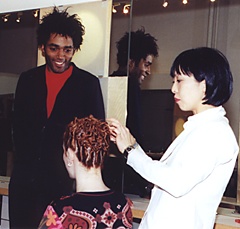
 |
|
|
Please write: dan@dancooper.tv
Return to Page One
Register here to receive Fashion Finds
email updates!

 FF:
Here’s another question in another direction: what percentage of people who are
either clients or they’re walk-ins, what percentage of people come in for haircuts or
color who want something that isn’t right for them? Like let’s say they’re
holding a picture of Elizabeth Hurley, but actually, you know, they may be short, blond
and a little plump or something. And they look completely different from the picture they
have torn out of a magazine. And the look isn’t right for them.
FF:
Here’s another question in another direction: what percentage of people who are
either clients or they’re walk-ins, what percentage of people come in for haircuts or
color who want something that isn’t right for them? Like let’s say they’re
holding a picture of Elizabeth Hurley, but actually, you know, they may be short, blond
and a little plump or something. And they look completely different from the picture they
have torn out of a magazine. And the look isn’t right for them. How do you talk them out of it in a way that is not disappointing to them, and at the same time also enhances whatever natural assets they have?
Penny Wang: I definitely have lots of new
clients who want something that’s not very suitable for them. Basically they have to
recognize who they are themselves, and what do they have that is worth bringing out. The
stylist’s job is basically to recognize a person’s best feature, and to educate
their clients about that. And basically try to bring their own natural beauty out, instead
of just copy cat to another celebrity or something.
FF: So what’s your opening sentence when you have to tell them that this isn’t you, and let’s look at what it is about you that’s beautiful. I mean how do you ease people into the shifting into a completely different gear?
Sherwin Jones: Ninety-nine percent of unhappy clients is basically due to communication. So as opposed to carrying out the service and trying to do something that you know is impossible, and that will disappoint the client, sometimes you can give them incentives. We can -- if it’s too short and if it’s dark, you can prepare them with the idea of wigs.
You know, go try on that length of wig, or that color wig, before making this whole changeover. Because it might look good on someone else, but if you feel that it might not be suitable for that person’s skin tone or height or cheekbones, whatever it may be, you know there’s all sorts of temporary things that can be offered.
Depending on how these things come across, you can also give them little incentives like, well in six months, you know, your hair will be about that long. Or you know, if in six months the condition isn’t up to par, it will harm you if you do color or perm, you know, and I’d like to give you some realistic views on what the potential may be.
The worst thing you want to do is to do a service that you don’t feel comfortable with, especially chemically speaking. You don’t want to do a service that’s going to harm the client or their hair. So if it comes to the point of refusing to do the service, it comes to that, but you know if you keep your sense of quality about the work that you do, then I guess you feel more comfortable in doing what you’re capable of doing. Things that are impossible, they’re simply impossible.
FF: Right, right.
Sherwin Jones: Once I had a client who came in for relaxing. She just came from the gym. Her pores were open. I refused to do the service, and I explained to her why. She did get upset and she left the salon. She had her hair relaxed, and you know, a great deal of it broke off, other than the fact that she had sores on the hair for a half year.
FF: Oh my gosh.
Alex Sansone: I think too, when people come in with a picture again, generally if it’s an unrealistic picture, even within that you can find what it is about that picture that they like, whether it’s the layering or whether it’s the color or whether it’s bangs, or the length.
So you find the essence of what it is that they like about it, and then prescribe what’s going to work best for their features. And also, very importantly, what’s going to work best for their lifestyle. Are they willing to spend an hour blow drying their hair every day?
Once you start telling people exactly what’s involved to make a certain look, it often will change the consultation, and then you’re able to talk them into something that is more realistic and suitable for them.
FF: I think that’s a very good point too. Just to follow up Sherwin on that story about the client who had come from the gym and her pores were open and you refused to relax her hair at that point, so as I understand, that means you -- if you relax somebody’s hair while their pores are open, what exactly happens?
Sherwin Jones: It’s chemically very irritating.
FF: I see.
Sherwin Jones: It burns. And if you know normally when we do a relaxer service, we suggest the client before having it done not to shampoo for a couple of days prior. And most people are aware of this, but sometimes, for example, this one woman she has to go somewhere; she was in the fashion business, you know blah, blah, blah. She needed to have this done.
But once again she did not need to have sores put on her head either, you know.
FF: But she actually came back and told you this story and returned.
Sherwin Jones: You never want these things
to happen, but you can explain with the amount of knowledge that you have, you can explain
reasons why. And once you know chemically it’s just better not to do certain services
that are going to be harmful to someone’s health, or that could cause long term
damage that will eventually have to grow out. You know those things tend to be a little
bit more touchy than just cutting a certain length. But that are equally important.
